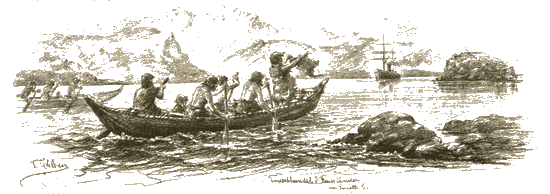Patagonia Bookshelf
Contacts between ships and natives groups, as reported in the English-language press
INTRODUCTION

Abstract
We analyse reports of contacts around the coast of Tierra del Fuego (including the western part of the Magellan Strait) between the crews of "western" ships and the indigenous population, principally marine nomads of the Kaweskar and Yamana groups. The study sample of 29 articles is drawn from English-language newspapers of Australia, New Zealand and USA, published in the period 1851-1900. Several of the articles give an account of the loss or abandonment of sailing ships, occasionally followed by dangerous encounters with local natives. Others are of a general, descriptive nature.
Newspapers were an important medium for communication of information in 19th century society; therefore, these sporadic reports can be considered to reflect public opinion, and perhaps to have shaped it. With the benefit of hindsight, it can be seen that certain statements and opinions presented in these reports are false or racially motivated. The reader should treat them as evidence of the prevailing discriminatory attitudes and fears of the period: unfortunately, even today, these have not been totally eliminated.
Early European visitors
From the first European visit to the region (Magellan, 1520) onward there had been occasional interactions between whites and natives [see "Terminology", below]. These were usually fleeting contacts, although not always peaceful ones. This status quo was to change significantly in the 19th century, with the longer-term presence of hydrographic and scientific expeditions, together with a steady growth in the volume of shipping taking the Cape Horn route.
Commercial shipping
Nineteenth century world trade was conducted by a large fleet of merchant ships. Goods and passengers moved between Europe and North America, and to more distant parts, like South Africa, the Far East, Australia and New Zealand. In English-speaking countries, shipping news was a regular part of newspaper content. Information about ship movements, especially delayed or lost vessels was important to owners, insurers and shippers, not to mention the families of crew members involved. Statements by survivors and witnesses were prominently reported.
Missionary dimension
Commensurate with the scope of trading interests across the globe, Christian missionary activity also increased — both within the English-speaking countries and elsewhere. Tierra del Fuego was one such region. Public interest had been excited, in part, by Captain Robert FitzRoy and naturalist Charles Darwin, whose accounts of this little-known part of the world, and its distinctive canoe nomads, living astride the sea-route between the Atlantic and Pacific Oceans, evoked curiosity and no little puzzlement. It seems that the highly-publicized deaths by starvation of the British missionary Captain Allen Gardiner and his companions in the Beagle Channel (1851) provided a point of focus for public attention.
Five decades of reports
From 1851 onward, native contacts in the Cape Horn region became newsworthy. Fatal outcomes were given prominent treatment, especially when a survivor reported how shipmates were drowned, or killed by natives. It was a long journey to safety: unless picked up at sea by a passing vessel, lifeboats needed to steer either for the Chilean settlement of Punta Arenas, or (after 1870) for the mission station at Ushuaia, or (after 1888) for the Argentine coastguard station at Good Success Bay. By the late 1880s, Argentine (and British) naval authorities felt able to announce that natives in the eastern district were trustworthy, but not all shipwrecked crews were prepared to believe this. There were two instances (City of Columbia and Spray) in which US citizens used fire-arms to warn off perceived attackers.
The high level of news attention was sustained until the first decade of the 20th century, by which time the number of indigenous people was in rapid decline, and incidents proportionately fewer. Steam power had become the dominant form of propulsion for ships: and, since these vessels were more manageable than sail, they preferred the shorter route through the Magellan Strait. For all practical purposes, the opening of the Panama Canal in 1914 marked the end of this type of encounter.
Terminology
Throughout this paper, the terms "native" is used to denote the indigenous people, and "white" to denote the sailors and passengers travelling in the passing ships.
Duncan S. Campbell
September 2012
Image of natives in canoe: Drawing by Theodor Ohlsen, reproduced in "Los Ojos de Ohlsen"
Appendix
The following additional articles were identified after this study was completed: